| LabGuy's World: Half Inch EIAJ
Portapack VTR's
New Addition 03.06.16 
 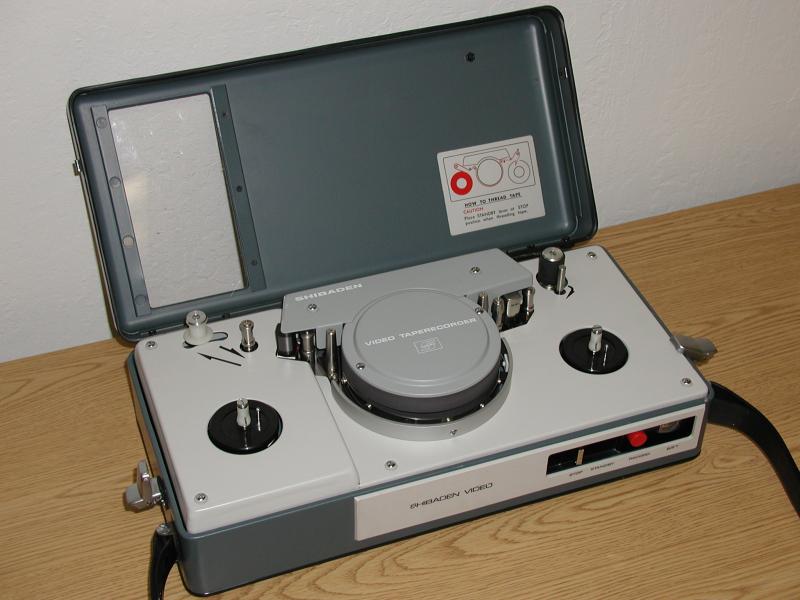 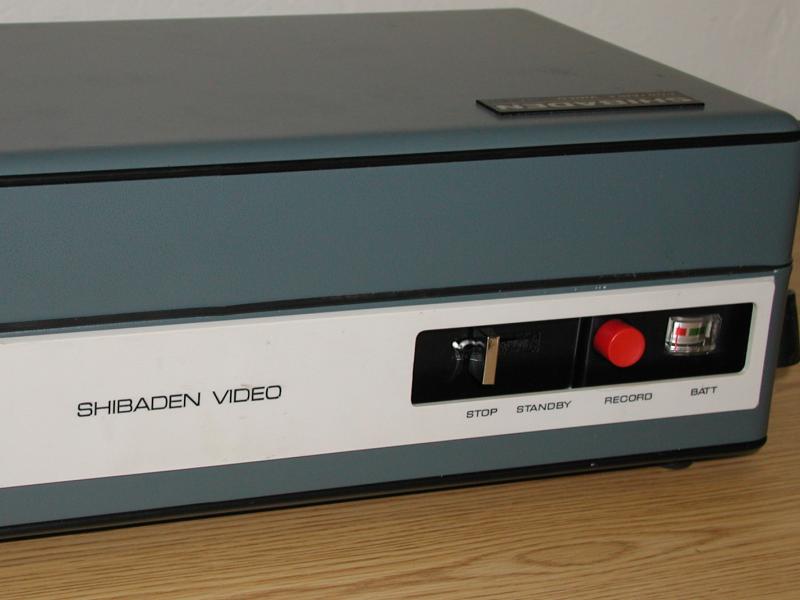
1970? Shibaden SV-550 EIAJ Record Only Portapack VTR Here is one I never heard of before! I did have photos of it, erroneously listed as an SV-707. A closer look at the SV-550 can reveal some significant differences. The most obvious visual differences are the diameter of the head drum and the "pitch" of the reels. On the SV-707, the feed reel (on the left side of the second photo) is lower than the take up reel and the tape "rises" as it travels about the head drum. On the SV-550, the feed reel is higher than the take up reel and the tape travels down and around the head drum. In the original "true" Shibaden format, the head drum has a noticeably larger diameter. For the EIAJ version, the drum is closer to five inches in diameter. This product was transitioned from its original format to the standardized EIAJ format, probably in or around 1969-70. Panasonic did a similar thing with its NV-8080 / NV-3080 record only portapack, shown later on this page. [CLICK HERE] to read the owner's manual for the SV-707. This is apparently a later "standardized" model based upon the SV-707. Functionally, the two VTRs are identical, except for the format. This unit is in extreme "like new" condition. The capstan belt has rotted out, or I would have loaded tape and taken it for a spin. The mating camera for this VTR is the Shibaden FP-707. The operation of this VTR could not be simpler. Place the function lever in stand-by, frame up the scene in the camera, pull the trigger and begin recording. When done, toss the tape on any EIAJ standard VTR and enjoy! 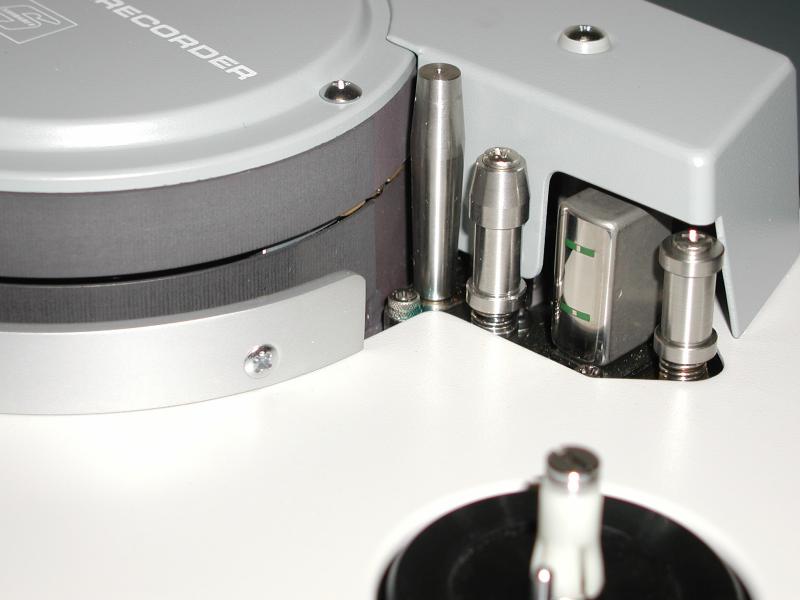 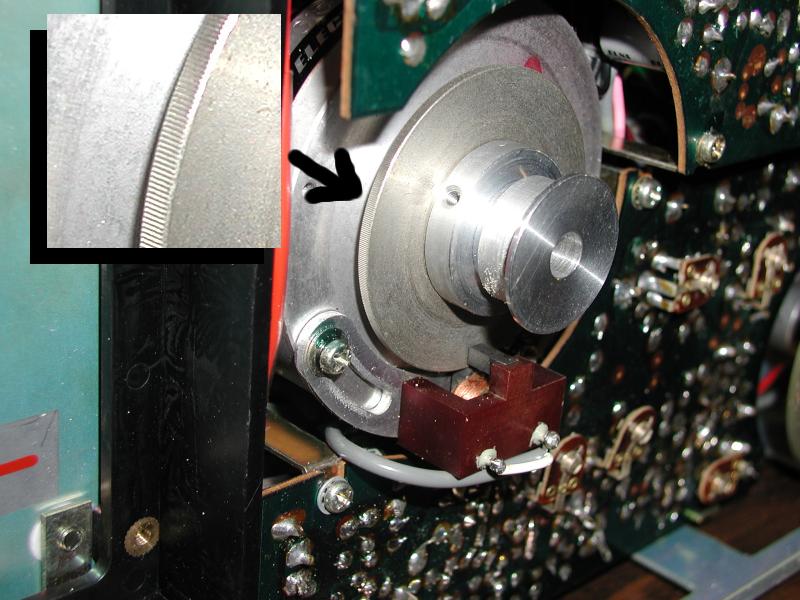 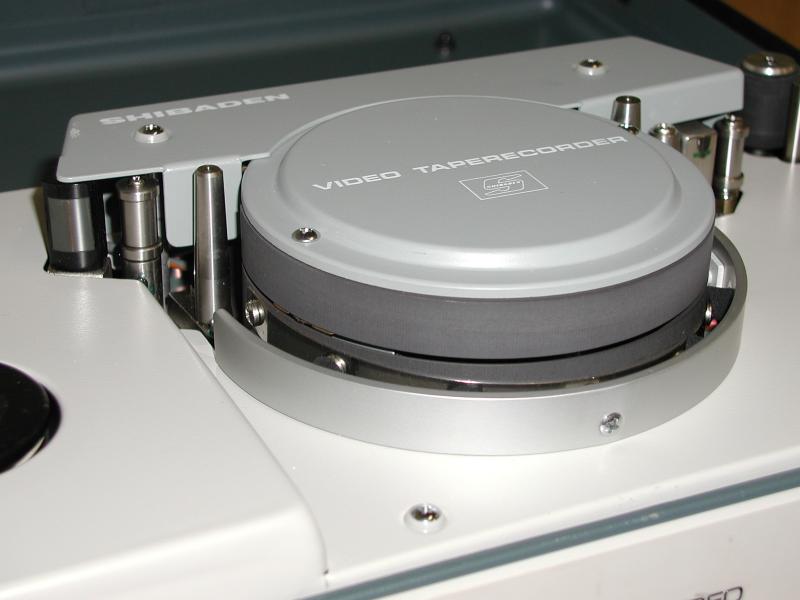
The Shibaden SV-550 head drum and mechanical sync generator There is a very clever mechanism built into almost all of these early B/W portapacks. First some background. If a VTR is moved suddenly, like when it is being carried about, the rotary head experiences the same forces as a gyroscope. The head will slow down or speed up depending on the direction of the motion. This is called gyro error. On playback, the picture on the monitor may actually shift left and right and, in extreme cases, it may lose horizontal sync altogether! If you could see the video pattern on the tape, you would see the space between the horizontal sync pulses varying as well as the length of the recorded video tracks. The solution is to create sync directly from the head wheel and capstan, errors and all, and drive the camera with it. This is called a Mechanical Sync Generator. Today, one of the reasons video recorders use very small diameter head drums is because it takes far less servo power to control it. A smaller mass responds to velocity changes faster too. The older machines need the larger heads to get the desired writing speed. There large mass made them slow to lock up and they consumed large amounts of precious battery power. I know this sounds crude, but ultra high power motor drive amplifiers, VLSI sync generator ICs, high density metal powder tape and one chip TBCs had not yet been developed. It's barely 1970! See the second photo. This is the bottom of the head drum with the capstan belt removed for clarity. A small metal wheel is attached to the shaft of the head drum. This wheel has 525* grooves machined in the edge of it, like a gear. These teeth pass near an electromagnet and induce a signal in it. This signal is amplified and shaped into horizontal sync pulse. On top of the drum, and not shown, are two other electromagnets which work in similar way to produce vertical sync pulses. These sync pulses drive the camera. The capstan flywheel is also driven by the head drum motor. This way, head rotation and tape motion are mechanically synchronized and track together. When the head speeds up, so does horizontal sync and so does the tape speed. If the head slows down, so does the horizontal sync and tape speed. Because everything is physically connected together, the interrelationship of all pulses is fixed. As the had revolves 30 times a second and the wheel has 525 teeth, the system produces 30 x 525 = 15,750 pulse per second that varies precisely with the gyro errors of real world recording! The camera scanning tracks right along. No matter what the instantaneous head speed, the pattern printed to tape now has perfectly spaced sync pulses! A playback VTR shows no evidence of the gyro errors present during the recording. Now, that's what LabGuy calls a real innovation! Even if it only works for B/W. TANSTAAFL - "There Ain't No Such Thing As A Free Lunch", said the wise man. Have you asked the next logical question? Where did the gyro error go? It ends up in the sound track. Recall that the capstan tracks the head speed, which was varying. Overall, the gyro error is a only a very small fraction of the total head and tape speed. In video, even this small amount of gyro error is intolerable. In audio, the gyro error appears as tape speed error. This is called "wow". At 2% or less the total value of wow is low enough to be unnoticeable except to the sharpest ear. It is most noticeable when the VTR operator turns to follow fast action. You hear the audio pitch bend up or down. . * 625 for CCIR . NEEDED: Service manual for the SV-707 and for the SV-550. Also seeking an FP-707 video camera (with service manual?) to complete the ensemble. New Addition 99.10 Updated 03.02.20 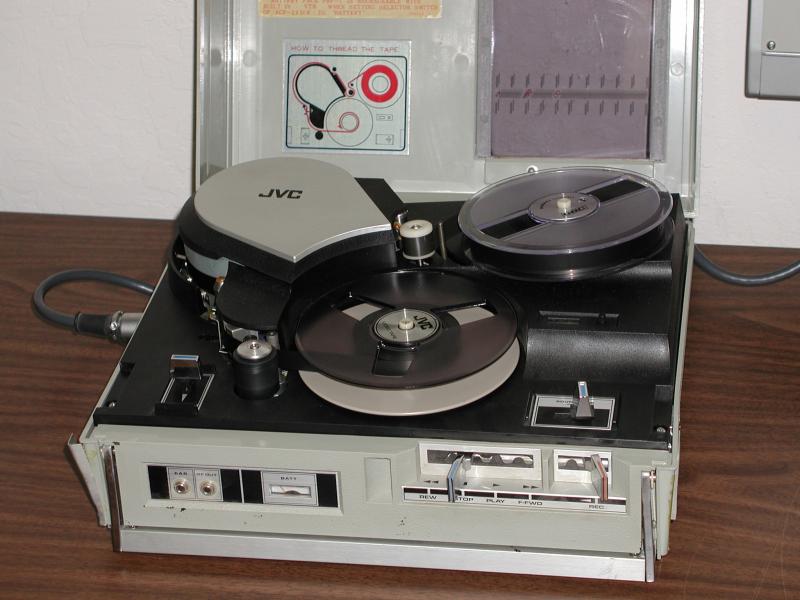 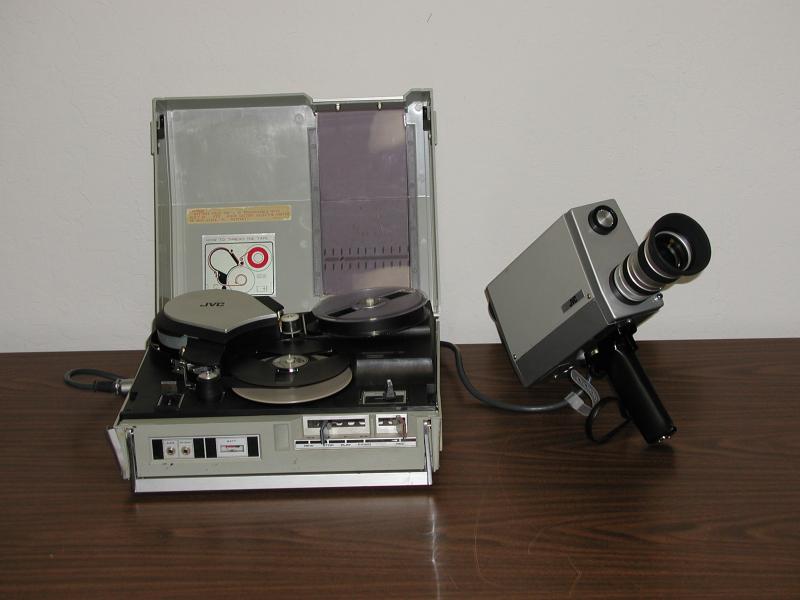 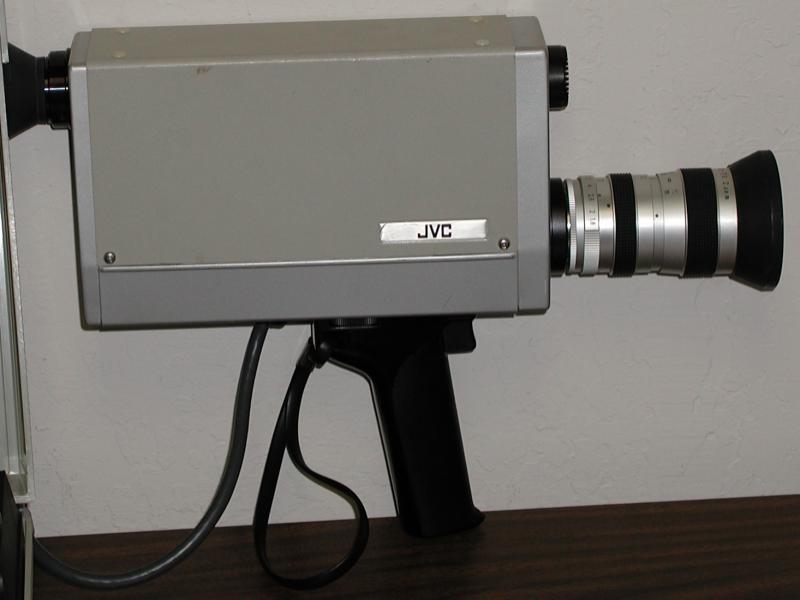
1974? JVC PV-4500 B/W Portapack VTR and GS-4500 Camera. This was JVC's answer to Sony's AV-3400 Video Rover system. This is the finest of all the portapack systems in this class too. EIAJ format, five inch reels of half inch tape give 30 minutes recording time. The large PBP-1 lead acid battery gives one hour running time on a full charge. Not shown is a toaster size AC power adapter and battery charger. Picture and sound quality border on excellent! This system is in excellent operational condition with the exception of the viewfinder CRT. (No light) A simple repair, no doubt. Another surprise was the "home movies" someone recorded in the 70s and possibly the 90s! The tape that came with the VTR was in perfectly playable condition. A great surprise, considering the age! By using a ten pin to eight pin adapter cable, I was able to play the VTR into my Sony monitor/receiver. There was also some contemporary test recordings near the front of the tape. Judging from the dialog, the camera is making a picture that is being recorded, but there was no image in the viewfinder. The little boy got it right when he declared, "I think this thing is recording, Dad!" (Kids are so sharp!) As the tape plays on, the recorded material regresses to earlier and earlier times. This system may have been used at a high school originally. . Instruction Manuals: PV-4500U VTR Operator's Manual GS-4500U Camera Operator's Manual ACP-22D AC Adapter Manual KVR-5U/KVR-6U RF Converter Manual . NEEDED: Service manual for the GS-4500 camera and the AC power supply. I have all other service and operator's literature. Updated: 03.03.02   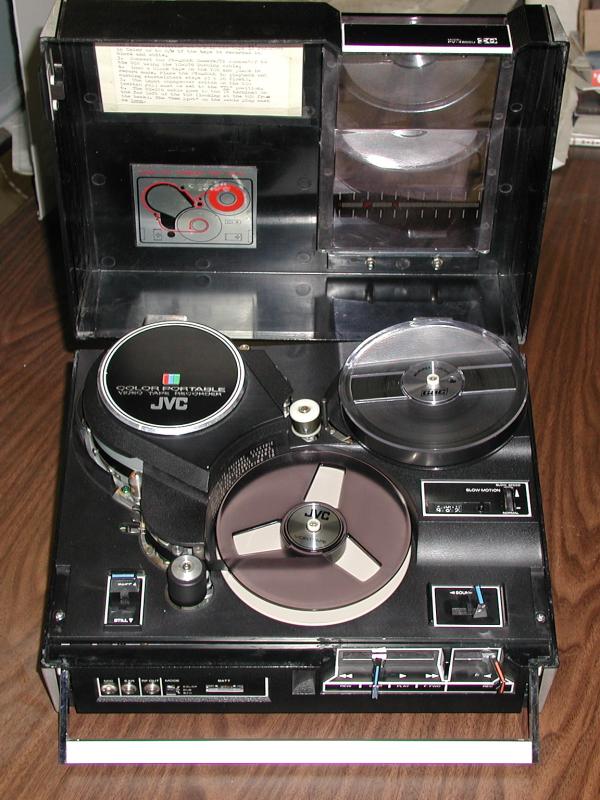 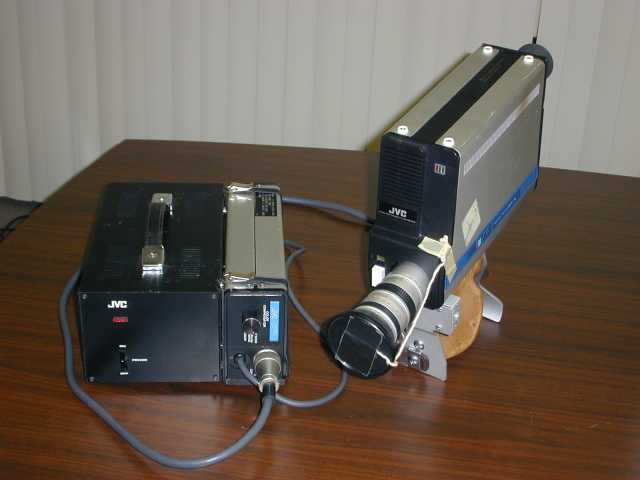
1976: The JVC PV-4800U Color Portapack VTR. This first picture, of the complete JVC 4800U system, comes from the sales brochure, which I obtained directly from JVC in 1975, while I was still in high school. (Better scan coming soon!) I've only seen this VTR in operation once, very briefly, in 1981. Image quality was excellent, for VTR's of that time. 1975 list price: $1995, which included the AC adapter, one battery and the leather carrying bag. This was the only EIAJ color portable VTR that did not require any external color adapters. The PV-4800U is a completely self contained color record/play VTR, requiring no further optional adapters or modules to operate in full color mode. The second and third photos are of the PV-4800U that is most recently added to my collection. LabGuy's World has a complete PV-4800 system with virtually all accessories, adapters, cases, cables, etc.! The camera and VTR are fully operational and undergoing restoration. More info to be posted as it becomes available. Stay Tuned! The matching camera for this VTR is the JVC GC-4800U, shown in the last photo. [CLICK HERE] to check out one of several that I have in my collection. The GC-4800U obtained with this, my second PV-4800U, is the first one that operates at all! In fact, it is working as well as these ever did. It uses a two tube system that never produced very good color fidelity. More info coming about these remarkable portable cameras coming soon. Stay tuned! . Instruction Manuals: PV-4800U VTR Operator's Manual PV-4800U Advertising Flyer from 1976 . New Addition! 99.11 Updated: 04.11.17 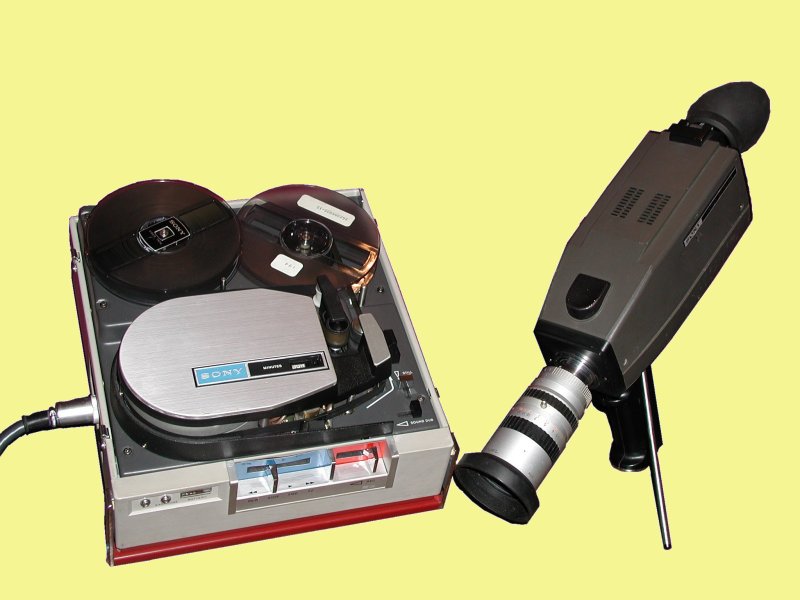 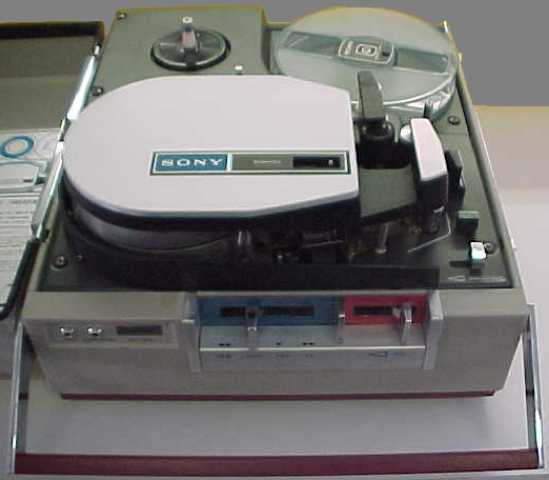 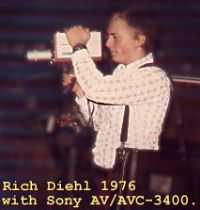
1970: Sony AV-3400 Portapack VTR and an AV Nerd in action!. This is the most mass produced of the reel to reel portapack VTR outfits. Produced by the thousands through out the early 1970's, this was probably Sony's most popular video product of it's time! This museum now has three complete AV-3400 systems plus quite a few spare cameras and other parts, some purchased, some donated. However, with all the effort collecting these VTR's, I've only got one with the original leather carrying bag. The leather bag can be seen in the third photo. During the life cycle of this product, two cameras were produced. The original camera was the AVC-3400, as seen in the last photo. In 1973, Sony came out with a more advanced and much lighter camera, the AVC-3450, seen in the first photo. The AVC-3400 weighed 7 pounds where as the AVC-3450 weighed only 4 pounds. Holding one of these for any length of time could be chore. I know, since I recorded a lot of basketball games at good ol' RBUHS (Red Bluff Union High School) in 1975 & 76. (Didn't care for the sports, but the cheerleaders were a minor consolation! AND I did get to rub my hands all over the. . . video equipment!!!) The AV-3400 recorded 30 minutes of black and white video and mono sound on 1200' of 1/2" tape running at 7-1/2 IPS and conformed 100% to the EIAJ type 1 standard. It had still frame capability and could run from it's internal battery for up to 45 minutes with a camera attached or 60 minutes playing into a standard TV using it's internal RF converter. Using a special 10 to 8 pin EIAJ cable and a receiver/monitor, it could record off-air programs, too. For AC operation, the AC-3400 power pack would be used. Donation acknowledgment: A second AV-3400 system was donated to my museum by Steven Sugar of Toronto, Canada in December, 1999. That brings the museum inventory of these beauties up to . . . three! In this last picture, the quintessential "AV nerd" demonstrates the proper posture to assume while using the AVC-3400 and AV-3400. (The polyester is optional!) . NEW! 02.08.25: [CLICK HERE] to read the operator's manual for the AV-3400. [CLICK HERE] to read the operator's manual for the AC-3400 AC Power Pack. [CLICK HERE] to read an advertising flyer for the AV-3400 portapack. New Addition & Photos: 01.04.23 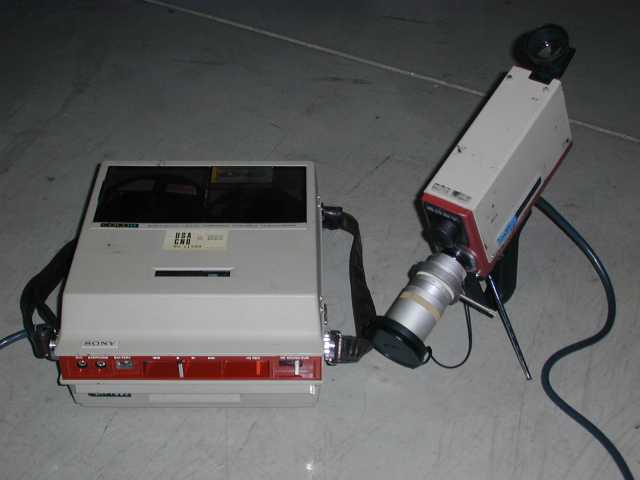 
1976: Sony AV-8400 EIAJ Color Portapack VTR. This was Sony's last EIAJ portapack VTR. After this one's time, 3/4" Umatic took over for all "serious" video production. The AV-8400 could use either the AVC-3400 or AVC-3450 black and white cameras when operating as a monochrome only system. The AV-8400 was not as convenient to use as a color model, however. It had a variety of optional plug in modules and an external color playback adapter as well. The color record module displaced the RF modulator module, meaning that tapes could not be played back on a standard TV, black and white or otherwise, if the AV-8400 was equipped to record color. (Compare this to the convenience of the fully self contained color JVC PV-4800U, below.) This unit had an auto threading feature as well, using special tapes that came with a stiff plastic leader tape at the start of the spool. I can't say how well this worked, since this particular machine needs belts. The AV-8400 was essentially a kluged up AV-3400, indicating that changes were taking place in the Sony engineering group back in Japan. I'll bet a dollar to doughnut that all of Sony's attention was being focused on the introduction of the Betamax product line by this time! Sadly, this model marks the end of the reel to reel's heyday. The photos show the second AV-8400 obtained by LabGuy's World. This machine is in very clean condition internally at least. The black gunk is what is left of the foam liner in the fiberglass shipping case. It is partially operational. Plays, records, but does not rewind. A typical case of rotten belts ~ no surprise there. The little "armstrong rewinder" crank from my DV-2400 worked on it just fine! The camera shown with the VTR is a B/W AVC-3400 workhorse. This machine was previously owned by the U.S. Army which explains why it is in such good condition. It came with the BP-30, 3 hour, NiCad external battery pack (not shown) which turned out to be good! Also not shown is the AC-1000 AC/Color adapter unit, CLP-8000 color playback adapter, CLP-8000R color record adapter, the roll around fiberglass shipping case and misc. accessories. This is one of the most complete extinct video outfits I have ever seen. New Addition! 00.12.15  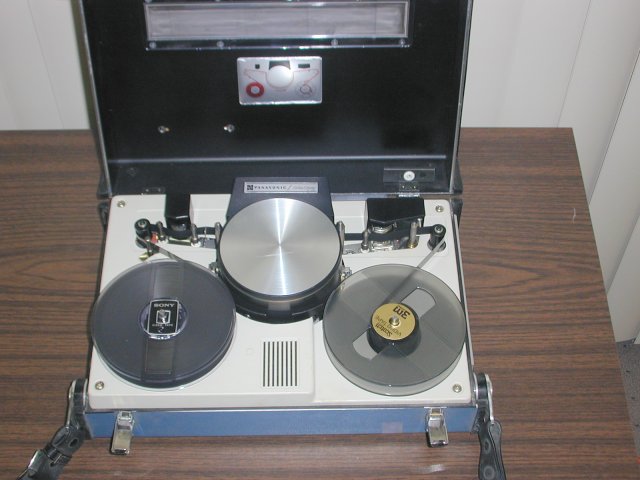
 
1970: Panasonic NV-3080 EIAJ *Record-Only* Portapack VTR 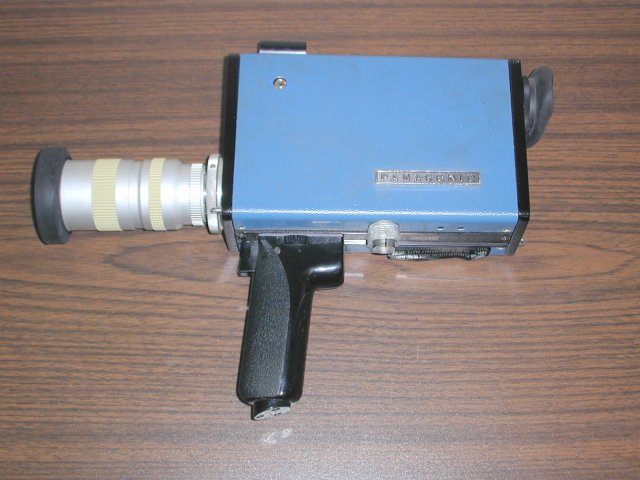 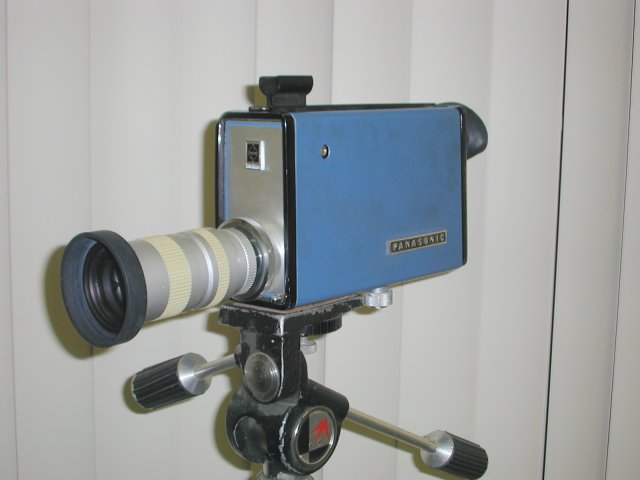
and the WV-8080 Vidicon / Viewfinder Portapack Camera! This is the earliest EIAJ portapack from Panasonic. Like the caption says, it is record only. Like the Sony DV-2400 skip field portapack, this Panasonic also has an "armstrong rewinder! This particular unit is very good condition, but will still need some TLC to bring it into a fully operational state. An AC power adapter would also help a lot, but is not mandatory. The camera has a 1-1/2" electronic CRT viewfinder for WYSIWYG shooting. The two pictures show the camera with, and without, the detachable pistol grip. I have the camera / VTR interconnecting cable, I just don't show it here. This one shows typical UPS shaved gorilla damage! It has serious dent in the upper front corner. Don't worry, LabGuy can fix it, he'll switch to Fed-Ex! As of 01.01.06, the museum has acquired its second NV-3080 tape deck (only). Go figure. I search for one of these for twenty years and then find two of them within thirty days of each other! NEEDED: Service manual and or operators' manuals for these items. 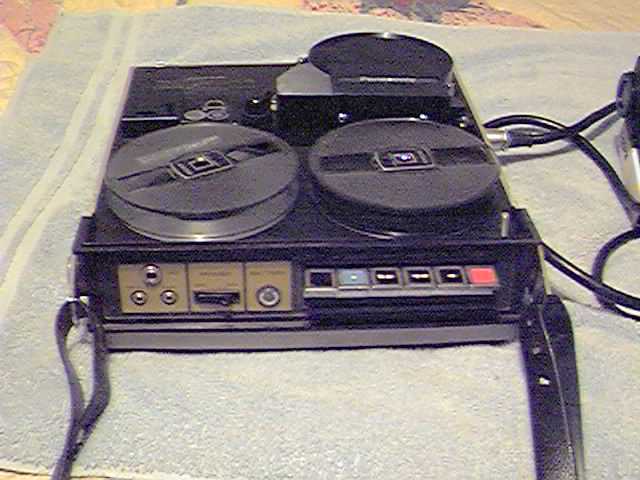 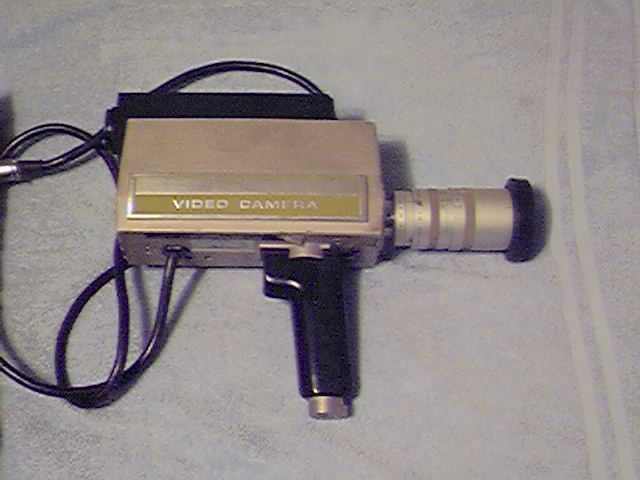
1972: Panasonic NV-3082 EIAJ portapack VTR and WV-3082 camera. The NV-3082 is color capable, using an external color adapter. Otherwise, fully EIAJ type 1 compatible, 30 minute recording on 1200' / 5" reels of 1/2" tape. This guy is also not the lightest of portapacks, weighing in around 30 lbs with camera, tape and two 6 volt gel-cell lead acid batteries. Running time was about one hour per charge. The unit operated from AC using the NV-B40 power pack. Playback was possible on a normal TV set using the built in RF modulator. Provisions are available for external microphone and an earphone for monitoring recording. The WV-3082 camera used a 2/3" vidicon tube and had a 1-1/2" CRT viewfinder for both recording and playback. The lens is the good old Fujinon 6:1 zoom used by everyone in those days. It was f1.2 and could zoom from 12.5 to 75 mm. F-stop, zoom and focus are all manual. The viewfinder had a flip up magnifier lens. Tape start / stop was controlled by a trigger switch in the handle. New Photos! 041120: 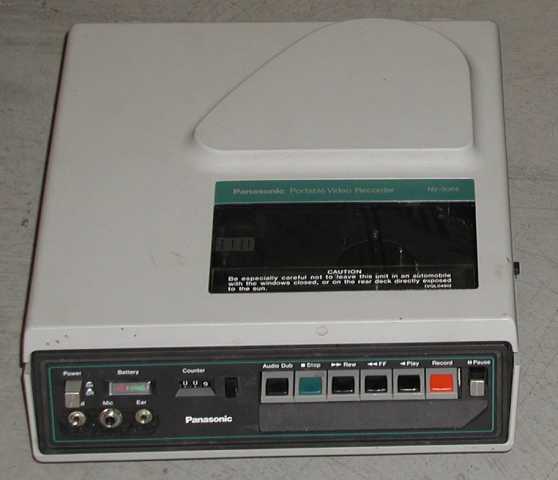 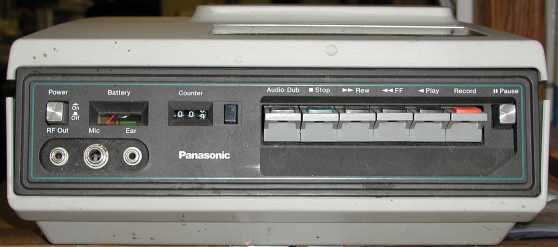 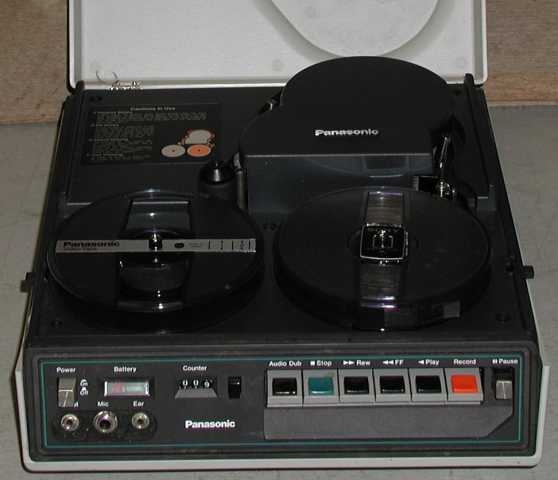
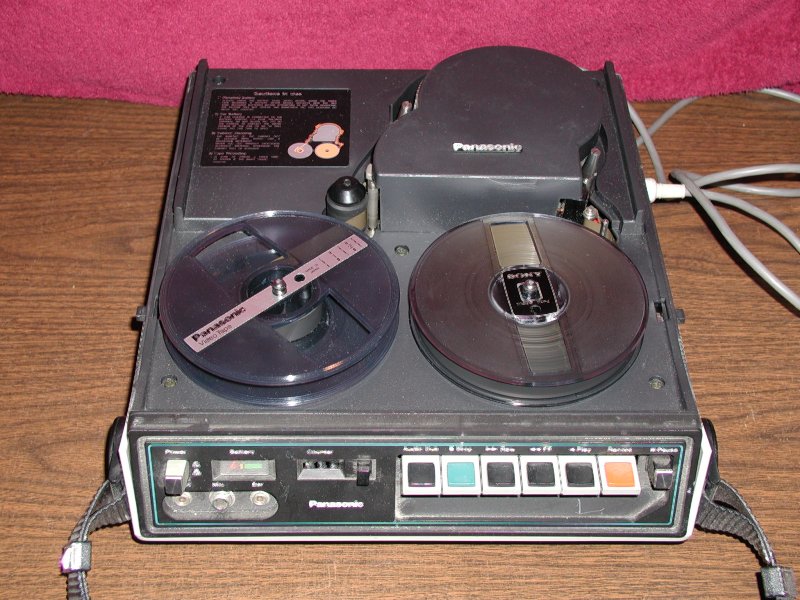 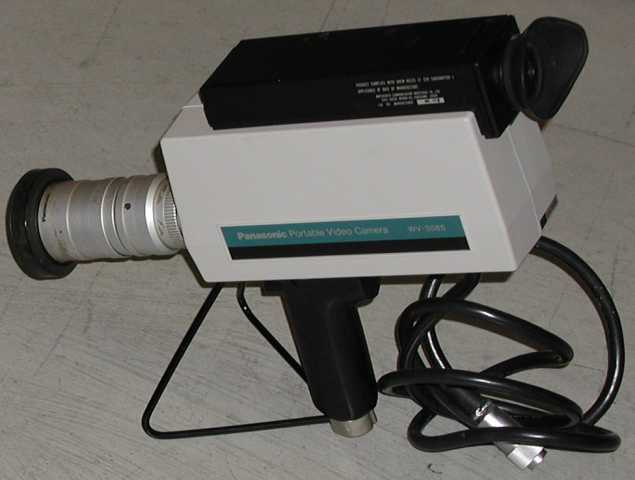 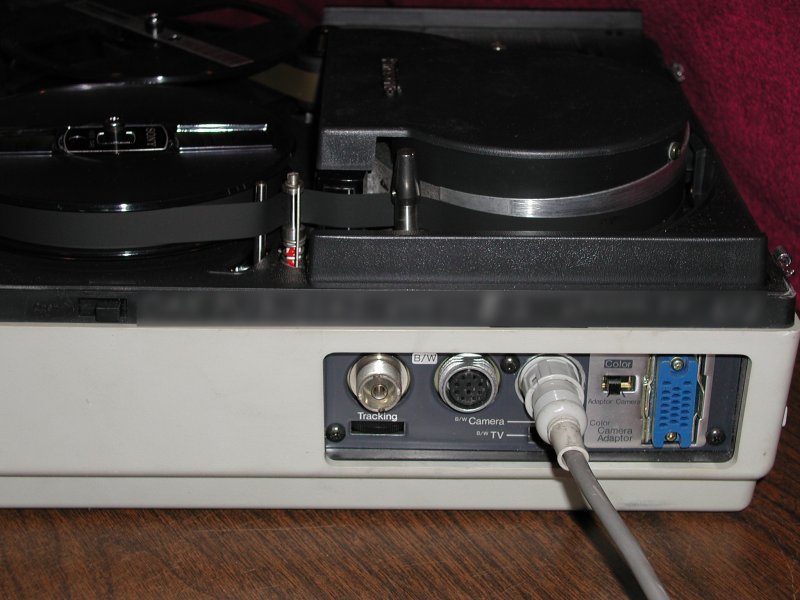
1974: Panasonic NV-3085 EIAJ portapack VTR and WV-3085 camera. What a lucky find! I was browsing at my local Goodwill Industries store one fine day, when I found this entire Panasonic portable EIAJ system. The package included the VTR, camera, power pack, batteries, some tapes and the heavy duty carrying case! This unit is color capable using an optional external color adapter. Anybody, out there, got one? . When I got this unit home, I was so excited that with out a second thought, I tried to play one of the tapes that had come with it. The old tape was no good, and resulted in breaking the video heads off. What a bummer! Since then I have purchased another NV-3085 VTR at eBay, the on line auction. Hopefully, it has video heads and this deck could become the spare parts unit. I'll keep you posted on how these events work out. . How time flies! All of that was at least five years ago! I got two or three more VTRs and at least one more complete outfit since then. Most of them are "operational. Meaning they require some new belts and a good cleaning before they could be used. The fourth and last photos are of the latest one. It is a much superior picture compared to the product of my earlier digital camera. Even the dust and grime shows up! . Click here to: Go to the Next Exhibit: Three Quarter Inch Umatic VCR's Return to the Exhibit Index Return to The Top of LabGuy's World Last updated: November 20, 2004 |